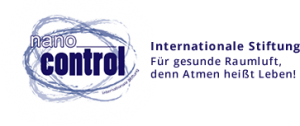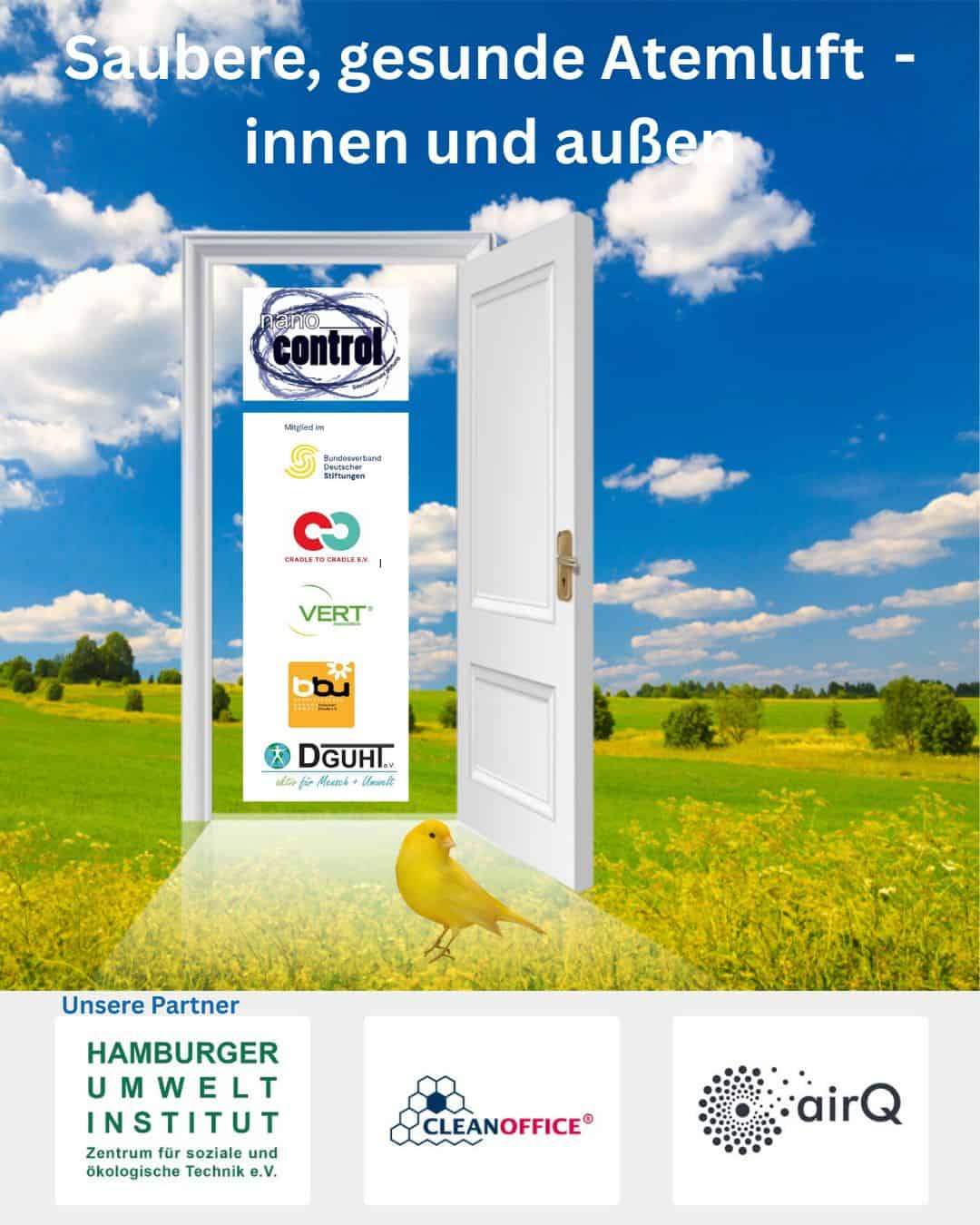The non-profit foundation nano-Control, International Foundation calls for mandatory rules for the operation of toner-based printing systems „laser printers“ to sustainably improve indoor air quality.
The human right to breathe clean air also applies to the air we breathe indoors.
„Briefing Air quality in Europe 2021 Air pollution is the single largest environmental health risk in Europe and has significant impacts on the health of the European population, particularly in urban areas.“ Source: European Environment Agency (EEA)
The voluntary nano-Control, International Foundation and its previous organization, the ITG citizens‘ initiative, have been working for almost 30 years on a vital issue: protecting the air we breathe indoors, because we need clean, healthy air to breathe. Breathing is living.
We spend more than 90% of our lives indoors. Over the course of 25 years, the nano-Control Foundation has received reports from 4,000 people who have identified the cause of a personal illness due to exposure to ultrafine emissions from laser printers and copiers. They often spent years searching for the causes of their multiple health complaints and some of them are seriously ill. The volunteer team tirelessly supports those affected with the knowledge gained from many years of counseling. One focus of the counseling is on the possibilities of prevention in the personal environment.
When laser printers are used indoors, the air quality is massively polluted and worsened by the emission of billions of ultrafine particles even when just one page is printed. Toner-based laser printers and copiers are a ubiquitous technology and, according to international studies, are a relevant source of indoor air quality pollution. In Germany, there are around 20 million devices in offices and publicly accessible rooms. Worldwide, there are hardly any legal regulations for indoor air quality (IAQ) that deal with the concentration of indoor pollutants.
During the pandemic, laser printers increasingly found their way into private homes through the establishment of home offices. In 2014, the German Federal Environment Agency stated that laser printers should never be placed in children’s rooms or bedrooms. However, there are still no mandatory regulations for the installation and handling of these technical devices.
Computer Bild also reported very recently on 16.12.2023 under the title „Fast, brilliant, cheap and harmful to health?“ about the potential dangers of emissions from laser printing devices.
Source: www.nano-control.org/computer-bild-farblaserdrucker-test-2024-mit-feinstaubmessungen-in-eigener-testkammer
Protecting children is our duty! Healthy, active children are our future!
Children are particularly affected by emissions from laser printers, which consist of ultra-fine particles, electrostatically charged metal particles, volatile organic compounds (VOCs), polycyclic aromatic hydrocarbons (PAHs) and many other pollutants. The development of our youngest children can be permanently disrupted by the unknown pollutant mix of tiny substances. There are no studies on this!
These ultrafine particles, which are so small that they are invisible to us, settle deep in the lungs and enter the bloodstream, can also cross the blood/brain barrier and reach every cell in our body directly. „The association between long-term exposure to ultrafine particles and high sensitivity C-reactive protein (hs-CRP), a blood biomarker for cardiovascular health, underscores the role of ultrafine particles in the complex mix of air pollution and their inflammatory potential.“ Source: Pilz et al. 2018
Scientific comparison with toasters and other household appliances
Since the turn of the millennium, the nano-Control Foundation, and before that the ITG, has been informing German employers‘ liability insurance associations, authorities and politicians about the risks and effects of emissions from laser printers on consumers / those affected. During this time, the effects of emissions from household appliances and burning candles were investigated with the result that the emissions from a toaster are allegedly similar to those from a laser printer.
nano-Control: We tell science that the comparison with the toaster is misleading. Toast is a controlled foodstuff whose emissions cause no or at most little harm to humans when used as intended. Nobody toasts for 8 hours a day for years or decades.
In 2001, the VBG employers‘ liability insurance associations found no scientific evidence of illness caused by toner dusts. In the meantime, the nano-Control Foundation has supported research in Germany with €120,000 in donations. The state had promised to promote further research, but this was not carried out, which we find incomprehensible.
„Plastic was at one time fantastic“
„The xerographic process is probably the third greatest money-making idea in the history of mankind, right after religion and compound interest.“ Source: Allan Fluharty 2005
In the early years, there were few problems with the laser printers. The ingredients were more crude. There were only a few, very expensive devices, and people were well aware of the dangers. Printer rooms were taped off. Employees were instructed. The older ones among us often remember streaky, uneven copies.
Nanotechnology opened doors for manufacturers at the turn of the millennium. The printing result improved immensely. The tiny particles could be printed precisely and they were distributed almost invisibly, even in the ambient air. The devices became suitable for mass production. According to current estimates, there are around 1 billion laser printing devices on our planet.
Composition of ingredients is a „dance on a knife edge“
The manufacturers‘ association BITKOM has announced that „toner preparations comply with the safety standards in the European Union. […] – According to the binding classification criteria for preparations of the European Union (Directive 1999/45/EC), toners for laser printers, copiers and multifunction devices of the original manufacturers organized in BITKOM are generally not classified as hazardous, i.e. in particular not classified as toxic, carcinogenic, mutagenic, toxic for reproduction, sensitizing or corrosive.“
The nano-Control Foundation points out that the toner mixtures also consist of polymers and that these are regulated in the EU’s REACH chemicals legislation. In 2005, representatives of the ETUC and DGB warned: „From an occupational health and safety perspective, the at least temporary exclusion of polymers from the obligation to register is a cause for concern.“
„The toners on the market consist mainly of a polymer (e.g. polyester, epoxy resins) as a matrix and coloring pigments (in the case of black toners, this is carbon black). The electrostatic charge is influenced by a number of additives so that an exact print can be produced.“ Source: BGRCI
The nano-Control Foundation knows that these mixtures of micro- and nanoplastic particles as well as various chemicals such as metals, e.g. Fe (iron), Al (aluminum), Ag (silver), As (arsenic), Au (gold), Cd (cadmium), Co (cobalt), Cu (copper), Cr (chromium), Fe (iron), Hg (mercury), Mn (manganese), Ni (nickel), Pb (lead), Pd (palladium), Sb (antimony), Si (silicon), Sn (tin), Sr (strontium), Ti (titanium), Zn (zinc), zirconium, tellurium, tungsten, tantalum and others.
From a recent safety data sheet from a laser printer manufacturer: „Although toner is not an aquatic toxin, microplastics can pose a physical hazard to aquatic life and should not be allowed to enter drains, sewers or waterways.“ Source: Safety Data Sheet A-18 Xerox Toner Black 2022
In addition to a perfect print image, chemical and metallic additives also have the functional task of preventing mould and rusting, improving flowability and also serve as plasticizers, for example. Investigations into emissions have revealed endocrine disruptors such as organotin compounds (DBT and TBT) and bisphenol-A, polycyclic aromatic hydrocarbons (PAHs), volatile organic compounds (VOCs), phthalates, volatile halogenated compounds, etc.
Indoor Air Quality and International Sciences
The corona pandemic has made the world particularly aware of the issue of indoor air and has led to a new recognition of the importance of air quality for human health, well-being, productivity and learning. Chinese scientists discovered in a clinic in Wuhan that the corona virus uses the charged laser printer particles as a vehicle to travel from person to person. Scientists have conducted intensive research into the behavior and effects of aerosols and particles in indoor environments.
An international group of experts led by QUT (Queensland University of Technology) draws a conclusion and calls for the global introduction of indoor air quality standards at the end of March 2024.
„We need to raise awareness that indoor air matters. Many indoor places are public, where individuals have little control over the quality of air they breathe. […] Introducing standards for air quality in public buildings recognises the right for those using the buildings to expect a safe and healthy environment, in the same way they should have confidence in food hygiene or fire safety.“
Source: Professor Cath Noakes, School of Civil Engineering, University of Leeds. 28.03.2024
More than 40 international experts, including German scientists have joined forces to recommend the setting of limit values for three important indoor pollutants: carbon dioxide (CO2), carbon monoxide (CO) and respirable PM2.5 particles – as well as legally binding rules for air exchange rates.
Paradigm shift on indoor air quality in the context of the pandemic, occupational health and safety and climate change: We need a rethink in terms of how we handle and regulate indoor air.
In the opinion of the nano-Control Foundation, the measures implemented in Germany to limit emissions from laser printers via the Blue Angel certification have by no means achieved the necessary effect to protect people. Only the latest generation of today’s most innovative, state-of-the-art technology is awarded Blue Angel certification „due to its particularly poor emissions“.
Millions of these devices continue to emit billions of tiny, dangerous particles that are invisible to us and pollute the air we breathe indoors. The German employers‘ liability insurance associations state that there is „no particular health risk when using the tested appliances as intended“.
Nobody checks that they are used as intended according to the manufacturer’s instructions for use. Indoor air measurements to identify hazards are still not mandatory. Defective appliances are not replaced, according to the motto: Where no plaintiff, there no judge?
The only thing we notice is the smell. If it smells chemical or metallic in any way, protective measures are always necessary!
„When the needs of human health conflict with the health needs of other living beings, the health needs of humans must take priority. However, if a comfortable lifestyle jeopardizes the sustainability of natural resources, priority must be given to protecting the ecosystem that sustains life.“
Source: Das Recht auf gesunde Innenraumluft. Bericht über WHO-Tagung | Bilthoven, Niederlande | 15. – 17. Mai 2000
Does the market regulate everything?
Analyses of the printer toner market show that it is difficult for manufacturers to submit to consumer protection and environmental conditions. The laws of the market for expansion and profit optimization prevail. „Strict government regulations on VOC emissions may restrain industry growth – Various international regulatory bodies such as FDA, OSHA, EU and others have enacted regulations and guidelines for printing toners used for product packaging in the food & pharmaceutical industries in order to maintain quality or mitigate the harmful/toxic effects of volatile organic compounds emitted into food & pharmaceutical products, on humans, and the overall environment. This trend is likely to persist and may act as a major hindrance to the global printer toner market expansion. However, the introduction of alternative materials with technological advancements may help to overcome this barrier.“
Source: Global Market Insights (GMI)
nano-Control: Our advices must become mandatory!
In addition to ventilation, the use of fine dust filters, monitoring the indoor pollutants and the use of cleaning devices- It effectively helps to set up toner-based laser printing devices in separate rooms with independent in and exhaust air. There are many international recommendations for this practice.
The most effective protection is to replace them with alternative technology such as inkjet printers, as tens of thousands of german authorities have already done with laser printers.
This is less harmful to indoor environments, can save money and you are also doing something for climate protection: you save 90% electricity and therefore CO2.
In addition to considering the energy efficiency of buildings, indoor spaces must be protected spaces for people in the future, also in the context of climate change, with clean air that we can rely on: because breathing means living!
Human right to clean air – also indoors!
Legal regulations on air quality give people the right to a safe and healthy indoor environment. The right to clean air has been a human right enshrined by the United Nations since 2022 and naturally applies equally to indoor air.
The EU has adopted stricter limit and target values for 2035 to improve air quality, in accordance with the air quality guidelines of the World Health Organization (WHO).
Ultrafine particles – invisible and breaking through all barriers!
The nano-Control Foundation is certain that another point needs to be considered, as the scientists conducting the research have not yet included an aspect that has not yet been fully investigated scientifically. The much smaller particles PM1 and PM0.1. These particles overcome all barriers, including the blood/brain barrier. Warnings from scientists must be respected, as the precautionary principle applies here.
„Air pollution is a silent epidemic, and PM0.1 is perhaps the quietest of all pollutants.“
(Schraufnagel 2020).
There is now an emerging consensus in the scientific community that ultrafine particles (UFP) cause systemic damage and penetrate deep into the lung tissue, bloodstream, brain and almost all other organs. These particles trigger inflammation and disrupt the immune system. A scientist investigating the effects of laser printer emissions came to the following conclusion:
„In particular, there is one group I really think should know about this: pregnant women. Because once a lot of these genes are changed, they get passed on through the generations. It’s not just you.““ (Nancy Lan Guo, West Virginia University 2020)
Accessibility Reinforcement Act (BFSG) from 2025 – Breathing air can be a barrier!
Accessibility for sensitized people indoors in Germany, especially for vulnerable groups, is not guaranteed. Severely disabled people are excluded from visiting doctors‘ surgeries, pharmacies, clinics, educational institutions, kindergartens, schools and cultural facilities.
Circular economy Toner and Cartridges – „Cradle-to-Grave“ Process
With reference to an alleged circular economy, the nano-Control Foundation concludes that this is largely a „cradle-to-grave“ process. The material mainly enters in the form of new raw materials and mainly exits as non-recyclable waste. Worldwide, laser printers and copiers consume around 1.2 billion tons of toner every year, large quantities of which end up polluting the environment!
This is primarily solid waste that is produced during processing at the end of use. The printed paper is actually „hazardous waste“ in terms of waste technology due to the metals and chemical contamination. This may also apply to recycled paper! Only about every 4th toner cartridge is reused, so 6 out of 10 toner cartridges end up in household waste, where it takes up to 450 years for the plastic printer cartridges to decompose; some components take 1,000 years to decompose.
Source: superpatronen.de
The disposal of cartridges in household waste is actually prohibited under threat of a fine. Waste toner is not recyclable. It is assumed that huge quantities of micro and nano plastic and metallic fine dust particles from printers are irretrievably dispersed into the air we breathe and the environment.
Supply chain is a „dirty business“
The supply chain from the process of manufacturing the toner and the filled toner cartridges through to their use by the end user and the handling and disposal of the cartridges, as well as the pollution of the air we breathe indoors with ultra-fine particles, is also a dusty, one could also say „dirty, business“.
Climate target „ZERO EMISSION“ – seize opportunities and extend to the indoor environment
The nano-Control Foundation estimates that if 20 million laser printers are replaced with inkjet printers, Germany will save around 1 terawatt hour of energy per year out of a total consumption of 550 terawatt hours per year in our country.
In addition to the CO2 savings for the old, dusty technology, there is a relevant side effect: people’s health, which can demonstrably improve immediately, because fine dust has been proven to make people ill!
Increasing Productivity – Don’t Waste Human Resources!
The nano-Control Foundation makes it clear that legal requirements can have a positive effect on the health, creativity and ultimately the productivity of employees who are in the vicinity of laser printers and copiers.
Companies use HR KPIs to measure various indicators (Key Performance Indicators are metrics used to measure performance in specific areas of a company).
Such analysis tools could also be used to show the positive effects of clean, unpolluted air for employees. Just try it out!
It has been proven that particulate matter, including that from laser printers, has health effects, including irritation of the lower and upper respiratory tract, asthma, COPD, lung cancer, cardiovascular disease, high blood pressure, stroke, thrombosis and deterioration of brain performance.
Author
Heike Krüger, Chairwoman
nano-Control, International Foundation
Our Partner
![]()





Hinterlasse einen Kommentar
An der Diskussion beteiligen?Hinterlasse uns deinen Kommentar!